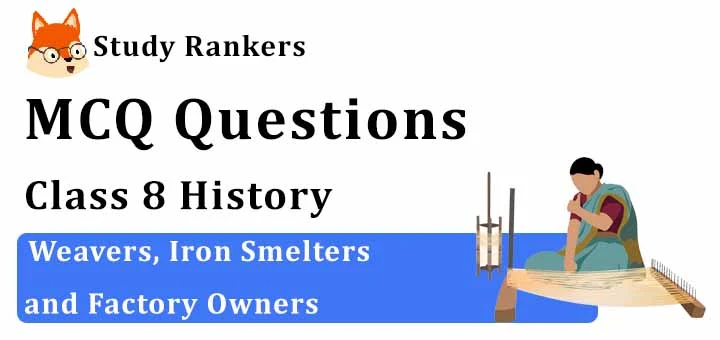MCQ Questions for Class 8 History: Ch 6 Weavers, Iron Smelters and Factory Owners

1. Why was the Indian textiles popular ?
(a) By its fine quality
(b) By its cheap price
(c) By its fine quality and exquisite craftsmanship
(d) By its exquisite craftsmanship
► (c) By its fine quality and exquisite craftsmanship
2. Complete the following. When its ________________________ industry started growing from the 1850s, Britain came to be known as the workshop of the world
(a) Silk
(b) Paper
(c) Cement
(d) Iron and Steel
► (d) Iron and Steel
3. Among the following, which place in Bengal was the important centre of Jamdani weaving ?
(a) Chittagong
(b) Shillong
(c) Lucknow
(d) Dacca
► (d) Dacca
4. Name the important weavers of Northern India from the following list
(a) Sale
(b) Devangs
(c) Julahas
(d) Kaikollar
► (c) Julahas
5. Name the machine that increased the productivity of the traditional spindles in textile industry
(a) Spinning engine
(b) Flying shuttle
(c) Steam engine
(d) Spinning Jenny
► (d) Spinning Jenny
6. Complete the following. An important cluster of weaving centre existed in the Coromandel coast, in the southern part of India stretching from ____________
(a) Dacca to Orissa
(b) Madras to Northern Andhra Pradesh
(c) Madras to Maharashtra
(d) Mumbai to Gujarat
► (b) Madras to Northern Andhra Pradesh
7. From where did the English word Chintz derive from?
(a) Texture
(b) Chhint
(c) China
(d) Consistency
► (b) Chhint
8. A few statements pertaining to the weavers of India are given below. Identify the one that is not True with respect to the weavers.
(a) Weavers often belonged to the communities that specialized in weaving.
(b) Weaving provided livelihood for many Indians
(c) The tanti weavers, julahas are some of the important weavers.
(d) Weaving skills were not passed on from one generation to another
► (d) Weaving skills were not passed on from one generation to another
9. Among the following, which place in Uttar Pradesh l was the important centre of Jamdani weaving?
(a) Kanpur
(b) Shillong
(c) Dacca
(d) Lucknow
► (d) Lucknow
10. By the early 18th century, who were worried about the Indian cotton textiles and popularity in England and started protesting?
(a) Traders in England
(b) Wool and Silk makers in India
(c) Weavers of Indonesia
(d) Wool and Silk makers in England
► (d) Wool and Silk makers in England
11. Bandanna is derived from the word bandhana. which one would be the most appropriate meaning of the word Bandanna ?
(a) Any bright coloured dress.
(b) A shirt
(c) A woolen shawl
(d) A bright coloured scarf for the neck or head
► (d) A bright coloured scarf for the neck or head
12. Apart from the English, who were the other traders who benefitted and traded the Indian textiles?
(a) Dutch and French
(b) Greek and Chinese
(c) Chinese
(d) West Indians
► (a) Dutch and French
13. Name the person who invented Spinning Jenny?
(a) Andrew Kay
(b) Thomas Kay
(c) James Kay
(d) John Kaye
► (d) John Kaye
14. Name the legislation in 1720 banning the use of printed cotton textiles chintz in England.
(a) Silk Act
(b) Calico act
(c) Bandanna Act
(d) Chintz Act
► (b) Calico act
15. Mechanised production of which textiles made Britain the foremost industrial nation in the 19th century ?
(a) Cotton
(b) Silk
(c) Mining
(d) Chemical
► (a) Cotton
16. It is believed that the word calico is derived from the name of a particular place in Kerala. Identify the place.
(a) Calicut
(b) Cochin
(c) Chittur
(d) Cannanore
► (a) Calicut
17. Around 1750, before British conquered Bengal, India was by far the world's largest producer of this. Which one of the following options will replace the term this here?
(a) Cotton textiles
(b) Cement
(c) Paper
(d) Coffee
► (a) Cotton textiles
18. Choose the first stage of production, a work done mostly by women.
(a) Spinning
(b) Dying
(c) Printing
(d) Threading
► (a) Spinning
19. In which place in present day Iraq did the European trader's first encountered fine cotton from India carried by Arab merchants?
(a) Basra
(b) Mosul
(c) Tekrit
(d) Baghdad
► (b) Mosul
20. Which one of the following does Muslin refer to?
(a) A type of coffee
(b) A fine cotton fabric
(c) A piece of metal
(d) A type of cultivation
► (b) A fine cotton fabric
21. The Europeans started using the term Chintz, derived from the Hindi word Chhint. What is the meaning of Chhint?
(a) A weaver
(b) A cloth made of silk
(c) A cloth with small and colourful flowery designs.
(d) An order ready to be shipped to Britain
► (c) A cloth with small and colourful flowery designs.
22. Name the place in Eastern Bengal, in present day Bangladesh, famous for its textile centre in the 18th century.
(a) Kishoreganj
(b) Jessore
(c) Dacca
(d) Puthia
► (c) Dacca

